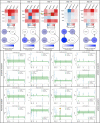Collateral sensitivity networks reveal evolutionary instability and novel treatment strategies in ALK mutated non-small cell lung cancer
- PMID: 28450729
- PMCID: PMC5430816
- DOI: 10.1038/s41598-017-00791-8
Collateral sensitivity networks reveal evolutionary instability and novel treatment strategies in ALK mutated non-small cell lung cancer
Abstract
Drug resistance remains an elusive problem in cancer therapy, particularly for novel targeted therapies. Much work is focused upon the development of an arsenal of targeted therapies, towards oncogenic driver genes such as ALK-EML4, to overcome the inevitable resistance that develops over time. Currently, after failure of first line ALK TKI therapy, another ALK TKI is administered, though collateral sensitivity is not considered. To address this, we evolved resistance in an ALK rearranged non-small cell lung cancer line (H3122) to a panel of 4 ALK TKIs, and performed a collateral sensitivity analysis. All ALK inhibitor resistant cell lines displayed significant cross-resistance to all other ALK inhibitors. We then evaluated ALK-inhibitor sensitivities after drug holidays of varying length (1-21 days), and observed dynamic patterns of resistance. This unpredictability led us to an expanded search for treatment options, where we tested 6 further anti-cancer agents for collateral sensitivity among resistant cells, uncovering possibilities for further treatment, including cross-sensitivity to standard cytotoxic therapies, as well as Hsp90 inhibitors. Taken together, these results imply that resistance to targeted therapy in non-small cell lung cancer is highly dynamic, and also one where there are many opportunities to re-establish sensitivities where there was once resistance. Drug resistance in cancer inevitably emerges during treatment; particularly with novel targeted therapies, designed to inhibit specific molecules. A clinically-relevant example of this phenomenon occurs in ALK-positive non-small cell lung cancer, where targeted therapies are used to inhibit the ALK-EML4 fusion protein. A potential solution to this may lie in finding drug sensitivities in the resistant population, termed collateral sensitivities, and then using these as second-line agents. This study shows how the evolution of resistance in ALK-positive lung cancer is a dynamic process through time, one in which patterns of drug resistance and collateral sensitivity change substantially, and therefore one where temporal regimens, such as drug cycling and drug holidays may have great benefit.
Conflict of interest statement
The authors declare that they have no competing interests.
Figures





References
Publication types
MeSH terms
Substances
LinkOut - more resources
Full Text Sources
Other Literature Sources

